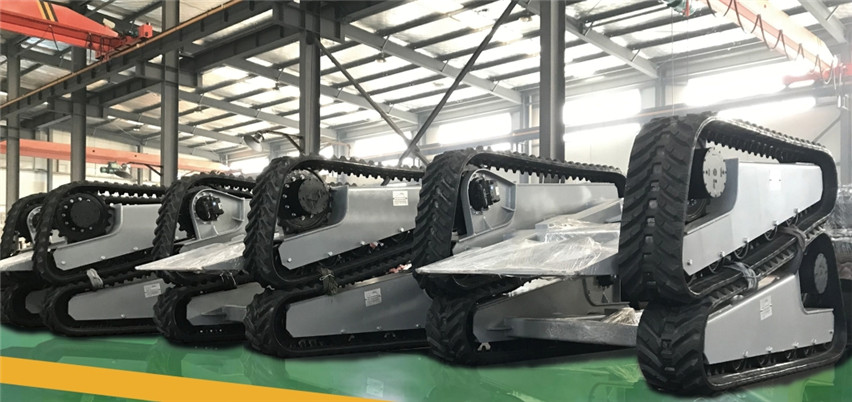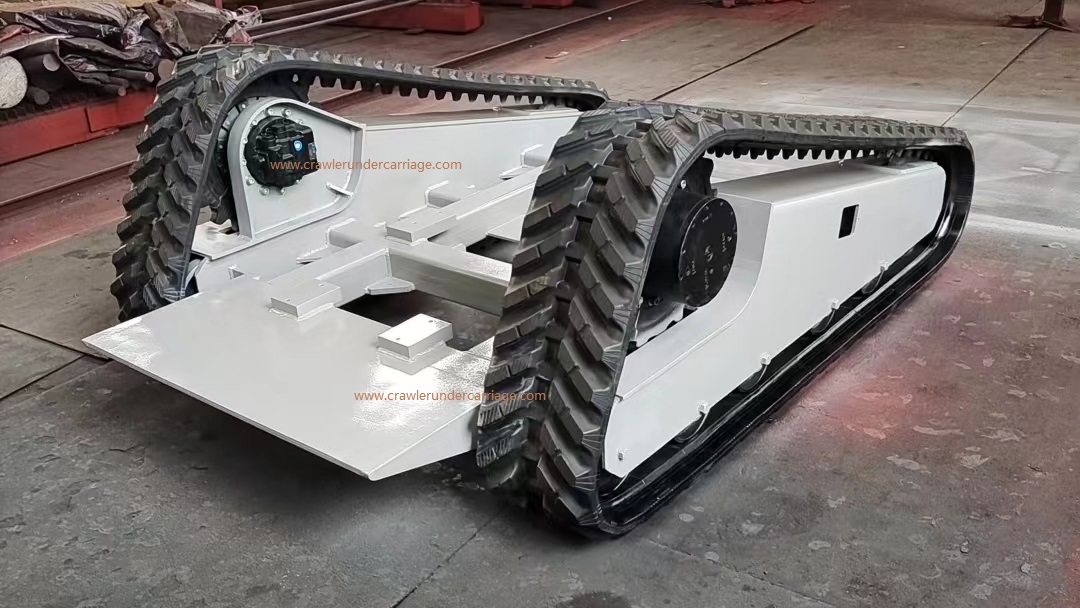Recently, our company has newly designed and manufactured a batch of triangular-structured track undercarriage, specifically for use in fire-fighting robots. This triangular frame track undercarriage has significant advantages in the design of fire-fighting robots, mainly reflected in the following aspects:
1. Superior Obstacle-Crossing Capability
**Geometric Advantage: The triangular frame, supported alternately by three contact points, can more efficiently traverse stairs, ruins, or gullies. The sharp front end can wedge under obstacles, using the lever principle to lift the body.
**Center of Gravity Adjustment: The triangular structure allows the robot to dynamically adjust its center of gravity distribution (for example, raising the front when climbing a slope and using the rear tracks for propulsion), enhancing its ability to climb steep slopes (such as those over 30°).
**Case: In simulation tests, the triangular tracked undercarriage robot's efficiency in climbing stairs was about 40% higher than that of traditional rectangular tracked robots.
2. Enhanced Terrain Adaptability
**Complex Ground Passability: The triangular tracks distribute pressure more evenly on soft ground (such as collapsed rubble), and the wide track design reduces the probability of sinking (ground pressure can be reduced by 15-30%).
**Narrow Space Mobility: The compact triangular layout reduces the longitudinal length. For example, in a 1.2-meter-wide corridor, traditional tracked robots need to adjust their direction multiple times, while the triangular design can move laterally in a "crab walk" mode.
3. Structural Stability and Impact Resistance
**Mechanical Optimization: The triangle is a naturally stable structure. When subjected to lateral impacts (such as secondary building collapses), stress is dispersed through the frame truss structure. Experiments show that the torsional stiffness is over 50% higher than that of a rectangular frame.
**Dynamic Stability: The three-track contact mode always ensures that at least two contact points are on the ground, reducing the risk of overturning when crossing obstacles (tests show that the critical angle for side overturning increases to 45°).
4. Maintenance Convenience and Reliability
**Modular Design: Each side's tracks can be independently disassembled and replaced. For example, if the front tracks are damaged, they can be replaced on-site within 15 minutes (traditional integrated tracks require factory repair).
**Redundant Design: The dual-motor drive system allows basic mobility even if one side fails, meeting the high reliability requirements of fire scenarios.
5. Special Scenario Optimization
**Firefield Penetration Capability: The conical front end can break through light obstacles (such as wooden doors and gypsum board walls), and with high-temperature resistant materials (such as aluminosilicate ceramic coating), it can operate continuously in an 800°C environment.
**Fire Hose Integration: The triangular top platform can be equipped with a reel system to automatically deploy fire hoses (maximum load: 200 meters of 65mm diameter hose).
**Comparison Experiment Data
|
Indicator |
Triangular Track Undercarriage |
Traditional Rectangular Track undercarriage |
|
Maximum Obstacle-Climbing Height |
450mm |
300mm |
|
Stair-Climbing Speed |
0.8m/s |
0.5m/s |
|
Roll Stability Angle |
48° |
35° |
|
Resistance in Sand |
220N |
350N |
6. Application Scenario Expansion
**Multi-machine Collaboration: Triangular robots can form a chain-like queue and pull each other through electromagnetic hooks to create a temporary bridge structure spanning large obstacles.
**Special Deformation: Some designs incorporate extendable side beams that can switch to a hexagonal mode to adapt to swampy terrain, increasing the ground contact area by 70% when deployed.
This design fully meets the core requirements of fire-fighting robots, such as strong obstacle-crossing ability, high reliability, and multi-terrain adaptability. In the future, by integrating AI path planning algorithms, the autonomous operation capability in complex fire scenes can be further enhanced.








